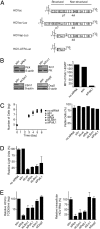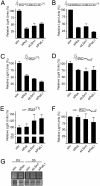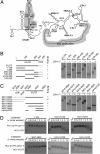Translation and replication of hepatitis C virus genomic RNA depends on ancient cellular proteins that control mRNA fates
- PMID: 19628699
- PMCID: PMC2714764
- DOI: 10.1073/pnas.0906413106
Translation and replication of hepatitis C virus genomic RNA depends on ancient cellular proteins that control mRNA fates
Abstract
Inevitably, viruses depend on host factors for their multiplication. Here, we show that hepatitis C virus (HCV) RNA translation and replication depends on Rck/p54, LSm1, and PatL1, which regulate the fate of cellular mRNAs from translation to degradation in the 5'-3'-deadenylation-dependent mRNA decay pathway. The requirement of these proteins for efficient HCV RNA translation was linked to the 5' and 3' untranslated regions (UTRs) of the viral genome. Furthermore, LSm1-7 complexes specifically interacted with essential cis-acting HCV RNA elements located in the UTRs. These results bridge HCV life cycle requirements and highly conserved host proteins of cellular mRNA decay. The previously described role of these proteins in the replication of 2 other positive-strand RNA viruses, the plant brome mosaic virus and the bacteriophage Qss, pinpoint a weak spot that may be exploited to generate broad-spectrum antiviral drugs.
Conflict of interest statement
The authors declare no conflict of interest.
Figures



Similar articles
-
Human La protein interaction with GCAC near the initiator AUG enhances hepatitis C Virus RNA replication by promoting linkage between 5' and 3' untranslated regions.J Virol. 2013 Jun;87(12):6713-26. doi: 10.1128/JVI.00525-13. Epub 2013 Apr 3. J Virol. 2013. PMID: 23552417 Free PMC article.
-
Modulation of hepatitis C virus RNA accumulation and translation by DDX6 and miR-122 are mediated by separate mechanisms.PLoS One. 2013 Jun 24;8(6):e67437. doi: 10.1371/journal.pone.0067437. Print 2013. PLoS One. 2013. PMID: 23826300 Free PMC article.
-
hnRNP L and NF90 interact with hepatitis C virus 5'-terminal untranslated RNA and promote efficient replication.J Virol. 2014 Jul;88(13):7199-209. doi: 10.1128/JVI.00225-14. Epub 2014 Apr 9. J Virol. 2014. PMID: 24719423 Free PMC article.
-
[Regulation of hepatitis C virus genome replication by microRNA-122].Uirusu. 2015;65(2):277-286. doi: 10.2222/jsv.65.277. Uirusu. 2015. PMID: 27760927 Review. Japanese.
-
[Structure and function of the non-coding regions of hepatitis C viral RNA].Postepy Biochem. 2006;52(1):62-71. Postepy Biochem. 2006. PMID: 16869303 Review. Polish.
Cited by
-
Structures and Functions of the 3' Untranslated Regions of Positive-Sense Single-Stranded RNA Viruses Infecting Humans and Animals.Front Cell Infect Microbiol. 2020 Aug 27;10:453. doi: 10.3389/fcimb.2020.00453. eCollection 2020. Front Cell Infect Microbiol. 2020. PMID: 32974223 Free PMC article. Review.
-
Structural and functional insights into Saccharomyces cerevisiae Tpa1, a putative prolylhydroxylase influencing translation termination and transcription.J Biol Chem. 2010 Oct 1;285(40):30767-78. doi: 10.1074/jbc.M110.106864. Epub 2010 Jul 14. J Biol Chem. 2010. PMID: 20630870 Free PMC article.
-
A host YB-1 ribonucleoprotein complex is hijacked by hepatitis C virus for the control of NS3-dependent particle production.J Virol. 2013 Nov;87(21):11704-20. doi: 10.1128/JVI.01474-13. Epub 2013 Aug 28. J Virol. 2013. PMID: 23986595 Free PMC article.
-
Hepatitis C Virus Exploitation of Processing Bodies.J Virol. 2016 Apr 29;90(10):4860-4863. doi: 10.1128/JVI.03056-15. Print 2016 May 15. J Virol. 2016. PMID: 26937026 Free PMC article. Review.
-
Neutralizing monoclonal antibodies against hepatitis C virus E2 protein bind discontinuous epitopes and inhibit infection at a postattachment step.J Virol. 2011 Jul;85(14):7005-19. doi: 10.1128/JVI.00586-11. Epub 2011 May 4. J Virol. 2011. PMID: 21543495 Free PMC article.
References
Publication types
MeSH terms
Substances
LinkOut - more resources
Full Text Sources
Molecular Biology Databases

